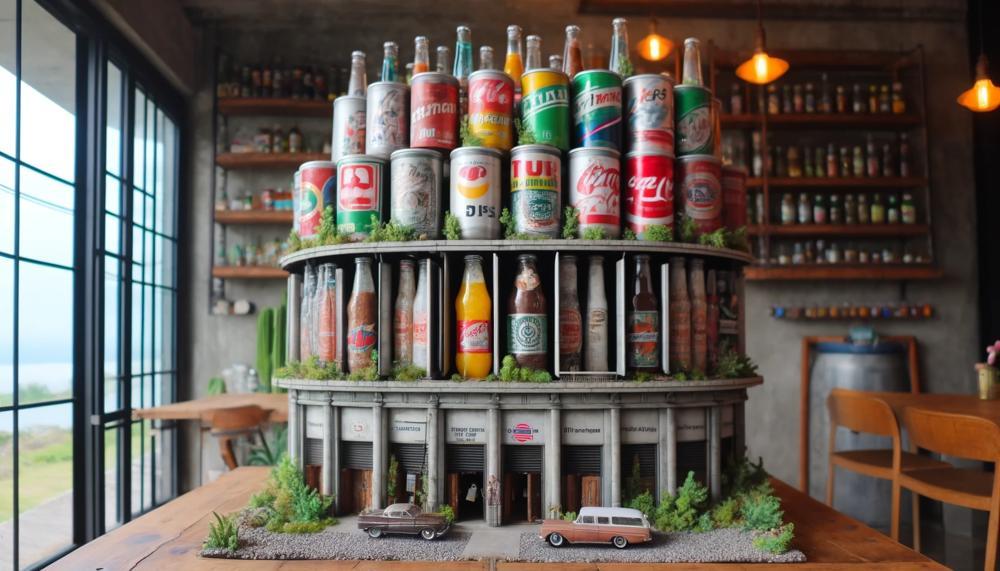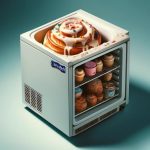Do you know that the ideal temperature to store soda is between 40 and 75 degrees Fahrenheit? That’s right, your favorite fizzy drink doesn’t necessarily need to be refrigerated at all times. While chilling soda can help to maintain its flavor and carbonation, there are other factors to consider when it comes to storing soda and preserving its quality.
Contents
- 1 What Happens if Soda is Stored in Hot Places?
- 2 The Impact of Temperature on Soda Shelf Life
- 3 Can Soda be Stored Outside?
- 4 The Benefits of Refrigerating Soda
- 5 Storing Soda in the Garage
- 6 The Effect of Temperature Changes on Soda
- 7 The Optimal Temperature for Soda
- 8 Storing Soda Cans in the Fridge Door
- 9 The Impact of Chilled Beverages on Taste
- 10 How Temperature Affects Drink Fizziness
- 11 Conclusion
Key Takeaways:
- Storing soda in a cool, dry place with temperatures between 40 and 75 degrees Fahrenheit is recommended.
- Soda cans stored in hot places can burst due to pressure build-up.
- Heat exposure can lead to a loss of fizz and flavor in soda.
- Refrigerating soda slows down the escape of carbon dioxide, preserving carbonation and flavor.
- The fridge door is slightly warmer, making it suitable for storing soda cans that require less cooling.
What Happens if Soda is Stored in Hot Places?
Storing soda in hot places can have detrimental effects on its quality. When exposed to high temperatures, soda cans can build up pressure and potentially burst. This can create a messy and potentially dangerous situation. Moreover, the flavor and fizziness of the soda can be compromised due to the heat.
To maintain the optimal taste and carbonation of soda, it is crucial to store it in a cool environment where the temperature remains within a safe range. It is best to avoid storing soda in locations where the temperature regularly exceeds 75 degrees Fahrenheit.
“The best way to store soda is in a cool, dry place,” says Sarah Johnson, a beverage expert. “Heat can impair the soda’s quality, resulting in a less enjoyable drinking experience.”
“Storing soda in hot places can be risky. Not only can it lead to burst cans, but it can also affect the taste and fizziness of the soda. To avoid these pitfalls, it’s important to keep soda in a cool environment.”
The Impact of Temperature on Soda Shelf Life
The shelf life of carbonated beverages, including soda, can be influenced by temperature. Proper storage temperature plays a crucial role in maintaining the quality and taste of soda throughout its lifespan. Let’s explore the effects of temperature on the shelf life of soda:
- Soda Shelf Life: The shelf life of soda varies depending on the type of soda and storage conditions. Regular sodas, which contain sugar, may start to flatten out after nine months past the expiration date. On the other hand, diet sodas, sweetened with artificial sweeteners, may start losing their sparkle three months after the expiration date.
- Temperature Impact: Heat exposure can significantly reduce the shelf life of soda. When soda is stored in high temperatures, the excessive heat can accelerate the chemical reactions within the soda, affecting its flavor and carbonation. This can lead to a shorter shelf life and a subpar taste experience.
“Proper storage temperature is crucial for preserving the quality and taste of soda.” – Beverage Storage Expert
It is essential to store soda in a cool place with temperatures between 40 and 75 degrees Fahrenheit to ensure its shelf life is maximized. By keeping soda away from extreme heat, you can enjoy a refreshing and fizzy beverage even after its expiration date.
| Type of Soda | Average Shelf Life (Past Expiration Date) |
|---|---|
| Regular Soda | 9 months |
| Diet Soda | 3 months |
Can Soda be Stored Outside?
When it comes to storing soda, many people wonder if it’s safe to keep their favorite fizzy drinks outside. The answer is yes, soda can be stored outside, but there are some important considerations to keep in mind.
First and foremost, temperature plays a crucial role in the preservation of soda’s flavor and fizz. It is recommended to store soda in a cool place with temperatures ranging from 40 to 75 degrees Fahrenheit.
If the temperature outside falls within this recommended range, then you can safely store your soda outdoors. However, it is important to note that extreme temperatures can have a negative impact on your carbonated beverages.
Direct sunlight and excessively hot temperatures can cause the soda to lose its fizz and flavor. Additionally, if the temperature exceeds 75 degrees Fahrenheit, there is a risk of the soda cans bursting due to the pressure buildup inside.
To illustrate this further, here is a table showing the effects of temperature on the preservation of soda:
| Temperature Range (Fahrenheit) | Effects on Soda |
|---|---|
| 40-75 | Soda stays fresh, flavorful, and fizzy |
| Above 75 | Risk of cans bursting, loss of fizz and flavor |
| Below 40 | Soda may become too cold and lose carbonation |
| Direct sunlight | Rapid loss of fizz and flavor |
By following these guidelines, you can enjoy your soda outdoors without compromising its taste and quality. It’s always important to consider the temperature and avoid exposing your soda to extreme conditions that can affect its flavor, fizz, and overall enjoyment.
The Benefits of Refrigerating Soda
Refrigerating soda is not just about keeping it cold; it also provides several benefits that contribute to the overall enjoyment of your favorite fizzy drink. By understanding the advantages of refrigerating soda, you can make an informed decision about how best to preserve its flavor and carbonation.
Preservation of Flavor
One of the key benefits of refrigerating soda is the preservation of its flavor.** Storing soda at a cold temperature helps to slow down the chemical reactions that can lead to flavor degradation.** Whether it’s a refreshing citrus soda or a classic cola, refrigeration helps maintain the taste profile that you know and love, ensuring each sip is as delicious as the first.
Retention of Carbonation
Another significant benefit of refrigeration is the retention of carbonation.** Carbon dioxide is responsible for the bubbles and fizziness in soda, and cold temperatures help to slow down its escape from the liquid.** By refrigerating your soda, you can keep it fizzier for a more extended period, so you can enjoy that satisfying burst of carbonation with every sip.
Refrigerating soda also prevents the buildup of excessive pressure inside the container.** When stored at lower temperatures, the solubility of carbon dioxide in the liquid increases, reducing the risk of cans bursting or experiencing unexpected leaks.** This provides an added benefit from a safety standpoint, ensuring your soda remains contained until you’re ready to enjoy it.
Enhanced Taste Experience
By refrigerating soda, you can enhance your taste experience.** Cold temperatures have a numbing effect on the taste buds, which may dull the perception of flavors.** To fully appreciate the intricate flavors present in your soda, allowing it to warm up slightly to a more moderate temperature is recommended.** Taking the time to let your chilled soda sit at room temperature for a short while before consuming allows the flavors to shine and provides a more satisfying taste experience.
Overall, refrigerating soda has numerous benefits, including the preservation of flavor, the retention of carbonation, and the ability to enhance the taste experience.** By keeping your soda chilled, you can ensure that each sip is as refreshing and delicious as the first, providing the ultimate enjoyment of your favorite fizzy drink.
Storing Soda in the Garage
When it comes to storing soda in the garage, the temperature conditions play a crucial role in maintaining its quality. To ensure the optimal preservation of soda, it is important to consider the temperature range of the garage.
If the garage temperature consistently stays within the recommended range of 40 to 75 degrees Fahrenheit, it is generally safe to store soda there. This temperature range helps to maintain the flavor and fizziness of the soda.
However, if the temperature in the garage becomes too hot or drops below freezing, it is not advisable to store soda in that environment. Excessive heat can cause the soda to lose its fizz and flavor, while freezing temperatures can potentially damage the container and affect the taste.
It is essential to find a cool place within the recommended temperature range to store soda, ensuring that it remains in optimum condition for consumption.
Benefits of Storing Soda in the Garage
Storing soda in the garage can have its advantages, especially if the temperature conditions are suitable. Here are a few benefits:
- The convenience of having soda readily available in a commonly used area like the garage.
- Saves space in the main refrigerator, allowing more room for other essential items.
- Keeps drinks cool and refreshing when enjoying outdoor activities or working in the garage.
While these benefits make storing soda in the garage appealing, it is crucial to prioritize temperature control to ensure the preservation of taste and quality.
| Temperature Range | Condition |
|---|---|
| 40 to 75 degrees Fahrenheit | Recommended |
| Above 75 degrees Fahrenheit | Not advisable |
| Below freezing | Not advisable |
The Effect of Temperature Changes on Soda
When it comes to soda, temperature changes can have a noticeable impact on its flavor and carbonation. Extreme heat exposure for a prolonged period can cause alterations in both taste and bubbly fizz. However, if you transfer a soda from a hot room to the refrigerator, as long as it hasn’t been exposed to extreme heat for extended periods, it should not cause any harm to the drink’s quality.
Rapid temperature changes can also affect soda’s carbonation levels. For instance, shaking up a soda that has been exposed to heat can lead to an increased release of carbon dioxide gas, making the drink go flat quicker.
It’s important to remember that while temperature changes can affect soda, moderate temperature fluctuations such as moving a soda from a warm environment to a cooler one are generally not a cause for concern. It is the prolonged exposure to extreme heat that poses the most significant risk to the quality of the soda.
Next, let’s explore the optimal temperature for storing and enjoying soda to ensure the best taste experience.
The Optimal Temperature for Soda
When it comes to enjoying a refreshing soda, the optimal temperature can significantly enhance your drinking experience. According to a spokesperson from Pepsi, the ideal temperature for soda is around 42 degrees Fahrenheit. However, it’s important to note that most household refrigerators are set at a colder temperature, typically around 35 degrees Fahrenheit.
To achieve the perfect temperature for your soda, it is recommended to let chilled drinks sit at room temperature for 30 minutes to an hour before consuming. This allows the soda to gradually warm up to a more enjoyable temperature, ensuring that your taste buds can fully appreciate the flavors and carbonation.
Why is the optimal temperature for soda important?
Soda is known for its fizzy and refreshing qualities, and the temperature at which it is served can greatly impact these characteristics. When soda is too cold, it can dull your taste buds and potentially mask the subtle flavors present in the drink. On the other hand, if the soda is too warm, it may lose its crispness and become flat.
“Finding the optimal temperature for soda is a balance between preserving the carbonation and allowing the flavors to shine.”
By allowing your chilled soda to warm up slightly, you can strike the perfect balance between preserving the carbonation and allowing the flavors to shine. This allows you to fully enjoy the taste and experience that soda has to offer.
Avoiding extreme temperatures
While the optimal temperature for soda is around 42 degrees Fahrenheit, it’s important to avoid exposing soda to extreme temperatures that can impact its quality. Freezing soda can cause the carbonation to expand, leading to potential container ruptures and a loss of fizz. Additionally, exposing soda to excessively high temperatures can result in a loss of carbonation and flavor.
Tip: Always store your soda away from direct sunlight and in a cool, dry place to help maintain its quality and taste.
Comparison of Soda Temperatures
| Temperature | Effect on Soda |
|---|---|
| Below freezing | Potential container ruptures due to carbonation expansion |
| 35-40 degrees Fahrenheit | Household refrigerator temperature; may result in slightly colder soda |
| 42 degrees Fahrenheit | Optimal temperature for enjoying soda |
| Above 75 degrees Fahrenheit | Potential loss of carbonation and flavor |
By understanding the optimal temperature for soda and taking the necessary steps to achieve it, you can elevate your soda-drinking experience and savor every sip.

Storing Soda Cans in the Fridge Door
When it comes to storing soda cans in the refrigerator, the fridge door is often a popular choice. But did you know that this is more than just an aesthetic preference? The fridge door actually has a slightly different temperature compared to the rest of the refrigerator, which makes it an ideal spot for items that require slightly less cooling, such as soda cans.
By storing your soda cans in the fridge door, you can keep them easily accessible and save space on the shelves. However, it is important to note that the temperature in the fridge door should still fall within the recommended range of 40 to 75 degrees Fahrenheit to ensure the optimal preservation of flavor and carbonation.
While the fridge door provides convenience, it’s crucial to maintain the right temperature to prevent any negative effects on the quality of your soda. So next time you’re organizing your refrigerator, consider utilizing the fridge door for storing your soda cans, but remember to keep an eye on the temperature to keep your fizzy drinks at their best.
The Impact of Chilled Beverages on Taste
When it comes to enjoying a refreshing soda, the temperature at which you consume it can greatly affect your taste experience. Chilled beverages certainly have their appeal, but did you know that they can actually have an impact on your taste buds?
Chilled beverages that are too cold can numb your taste buds, temporarily impairing your ability to fully savor the flavors in the drink. This is why it is recommended to avoid drinking soda that is excessively cold. While it may seem counterintuitive to not enjoy a chilled beverage right away, giving it a short time to sit at room temperature before consuming can actually enhance the taste experience.
Allowing a chilled soda to warm up slightly allows the flavors to unfold, making them more prominent to your taste buds. The mild temperature change can awaken your senses, ensuring that you fully appreciate the nuances and complexities of the soda’s taste profile.
It’s worth noting that the ideal temperature for chilling beverages is around 40 degrees Fahrenheit, as this allows them to be cold without being excessively icy. This gentle chill ensures that the drink is refreshing without numbing your taste buds.
“Letting chilled drinks sit at room temperature for a short time before consumption can enhance the taste experience.”
By taking a moment to let a chilled beverage warm up slightly, you can enjoy a more pleasurable and flavorful drinking experience.
How Temperature Affects Drink Fizziness
Carbon dioxide is responsible for the fizziness in soda. This gas is dissolved in the liquid under pressure during the carbonation process. As the temperature increases, the kinetic energy of the carbon dioxide molecules also increases, causing them to move more rapidly. This increased movement leads to the formation of more gas bubbles, resulting in a higher release of carbon dioxide from the liquid, and consequently, a decrease in drink fizziness.
When soda is exposed to higher temperatures, the carbon dioxide escapes more rapidly, leading to a loss of carbonation and a flatter, less fizzy drink. The rate of carbonation loss is directly proportional to the temperature. Therefore, the warmer the soda, the faster the carbonation will be lost.
To maintain the fizziness of your soda for a longer time, it is recommended to keep it cold. Lower temperatures slow down the motion of the carbon dioxide molecules, reducing the number of bubbles formed and, therefore, the rate of carbonation loss. Storing soda in the refrigerator or keeping it chilled in an ice bucket can help preserve its fizziness.
“The colder the drink, the slower the carbonation loss. Keeping soda cold is key to maintaining its fizziness for a longer time.”
It’s worth noting that different sodas may have varying levels of carbonation, and the impact of temperature on fizziness can vary between brands and flavors. Additionally, excessive shaking or opening and closing the container frequently can also accelerate the release of carbon dioxide and cause the soda to go flat more quickly.
The Best Temperature for Optimal Drink Fizziness
While the ideal temperature for maintaining maximum drink fizziness may vary depending on personal preference, experts generally recommend storing soda at a temperature below 40 degrees Fahrenheit (4 degrees Celsius) to ensure optimal carbonation preservation. However, it’s important to note that excessively low temperatures, such as freezing, can cause cans or bottles to rupture due to the expansion of the liquid inside.
It’s a good practice to allow chilled soda to sit at room temperature for a short time before consuming. This allows the drink to warm up slightly, allowing the full range of flavors to be experienced and preventing the numbing sensation that excessively cold drinks can have on taste buds.
Conclusion
To maintain the flavor and fizziness of soda, it is crucial to store it in a cool environment with temperatures ranging from 40 to 75 degrees Fahrenheit. While refrigerating soda is the optimal method for preservation, storing it in a place that falls within the recommended temperature range can also help retain its quality.
By following these guidelines, soda enthusiasts can enjoy their favorite carbonated beverages with maximum freshness. Ensure the longevity of soda’s taste and carbonation by refrigerating or storing it in a suitable location. This simple practice guarantees a satisfying soda experience, sip after refreshing sip.
For long-lasting soda enjoyment, remember that proper refrigerating and preservation are the key factors. Keep your soda cool, maintain its pristine taste, and enjoy the refreshing effervescence whenever you reach for an ice-cold can or bottle.
Source Links
- https://cooking.stackexchange.com/questions/99948/soda-water-first-stored-in-refrigerator-and-then-at-room-temperature
- https://www.tastingtable.com/834704/the-reason-you-should-store-soda-in-your-refrigerator-door/




